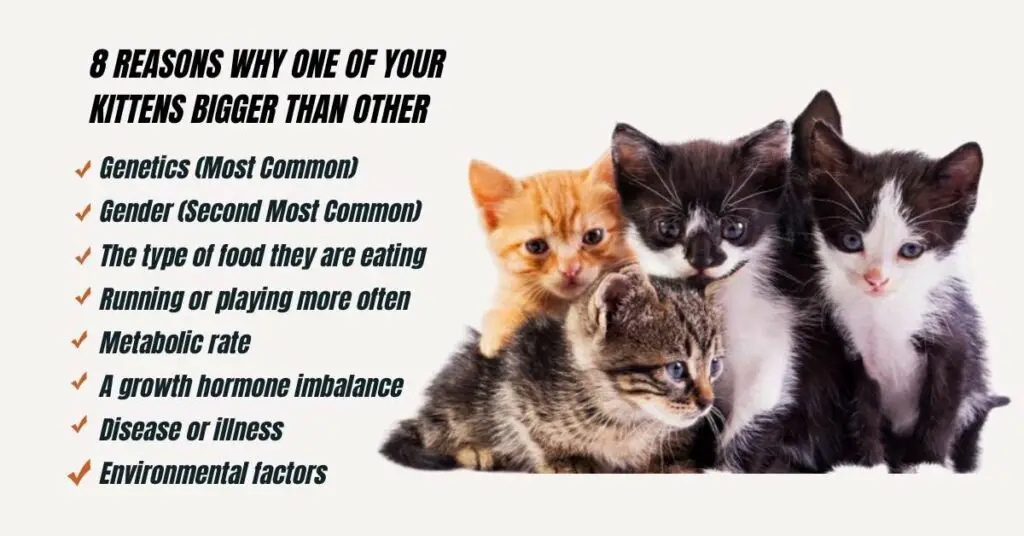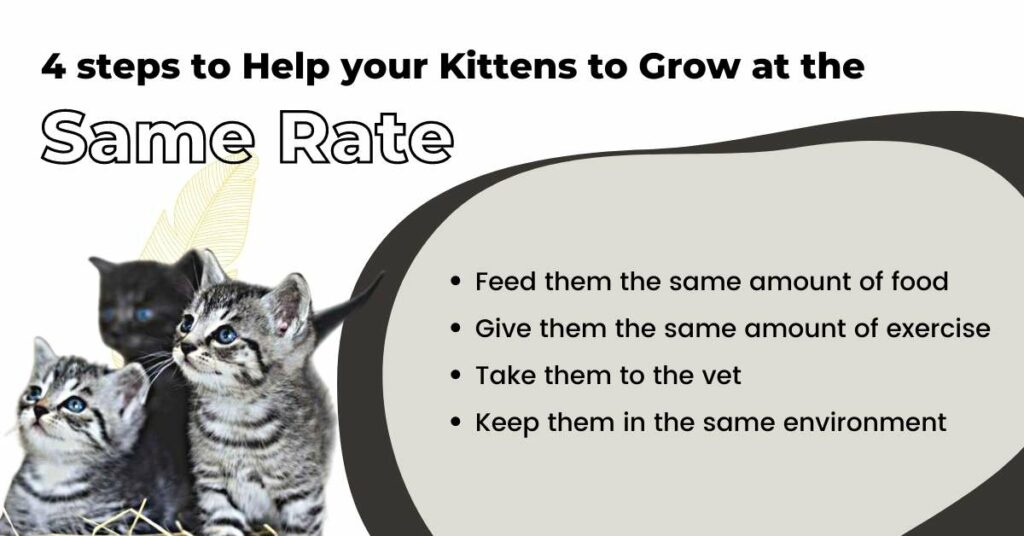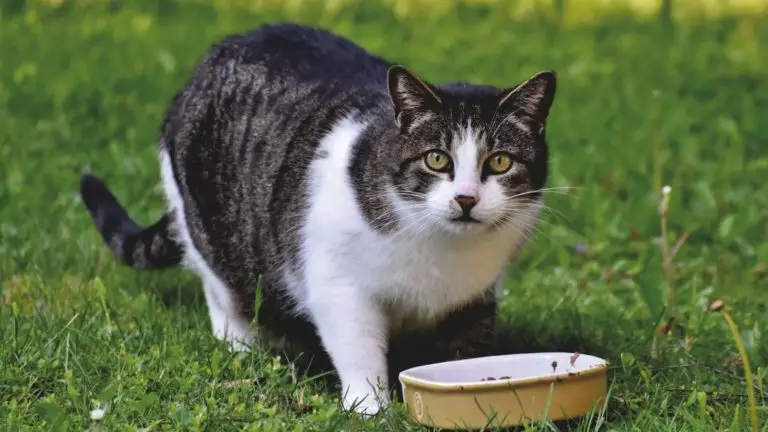Why is One of My Kittens Bigger Than the Other?
I want to share a story about two kittens that were born in my home. About six weeks ago, we had a litter of kittens born to one of our cats.
There were four in the litter, and they were all pretty much the same size…until recently. One of the kittens, we’ll call her Kitty A, seems to have grown twice as fast as her siblings. Kitty A is now about twice the size of the other kittens, and we’re wondering why.
In this blog post I’ll dive into the potential reasons behind why one of my kittens is much bigger than the other, and what, if anything, we can do about it.
So keep reading to learn more about this intriguing kitten phenomenon!
8 Reasons Why One of Your Kittens Bigger Than Other
It isn’t unusual for people to wonder why one of their kittens is bigger than the other. After all, kittens are born roughly the same size, and they usually grow at a similar rate until they reach adulthood. So, what causes this apparent discrepancy?
Here are all the potential reasons why one of your kittens may be bigger than the other:

- Genetics (Most Common)
- Gender
- The type of food they are eating
- Running or playing more often
- Metabolic rate
- A growth hormone imbalance
- Disease or illness
- Environmental factors
Now, let’s take a closer look at each of these factors to see how they may influence a kitten’s growth.
1. Genetics (Most Common)
The vast majority of the time, the reason why one kitten is bigger than the other is simply due to genetics. In other words, some kittens are just born larger than others and there’s nothing you can do about it.
Of course, the size difference may not be apparent at first since all kittens are small. However, as they grow older, the larger kitten will become increasingly bigger than the others.
2. Gender (Second Most Common)
Another potential reason for why one kitten is bigger than the other is gender. In general, male kittens tend to be larger than females, so if you have two males or two females, this may explain the size difference.
A study published in the Journal of Heredity found that, on average, male kittens weigh about 5% more than females. So, if you have one male and one female kitten, this may be why the male is bigger.
3. The type of food they are eating
The type of food a kitten eats can also influence its size. For example, kittens who eat wet food tend to be larger than those who eat dry food.
A study published in the Journal of Experimental Biology found that kittens who were fed a diet of wet food gained more weight than those who were fed a diet of dry food. So, if you’re feeding your kittens different types of food, this may explain the size difference.
4. Running or playing more often
Another potential reason for why one kitten is bigger than the other is exercise. Kittens who run and play more often tend to be larger than those who don’t get as much exercise.
A study published in the Journal of Applied Physiology found that cats who exercised regularly were larger than those who didn’t exercise. So, if your kittens have different activity levels, this may explain the size difference.
5. Metabolic rate
The metabolic rate is the rate at which the body burns calories. Kittens with a higher metabolic rate tend to be larger than those with a lower metabolic rate.
A study published in the Journal of Experimental Biology found that kittens with a high metabolic rate grew faster and were larger than those with a low metabolic rate. So, if your kittens have different metabolic rates, this may explain the size difference.
6. A growth hormone imbalance
Growth hormone is a hormone that helps regulate growth and development. An imbalance of this hormone can cause one kitten to be larger than the other.
A study published in the Journal of Experimental Zoology found that kittens with a growth hormone imbalance were larger than those without an imbalance. So, if your kittens have different levels of this hormone, this may explain the size difference.
7. Disease or illness
Disease or illness can also cause one kitten to be larger than the other. For example, if one kitten has a parasitic infection, this can cause it to gain weight and become larger than the other kittens.
A study published in the Journal of Parasitology found that kittens with a parasitic infection were heavier and had a higher body mass index than those without an infection. So, if your kitten is sick, this may be why it’s larger than the others.
8. Environmental factors
Finally, environmental factors can also influence a kitten’s size. For example, if one kitten is born in a warmer environment, this can cause it to be larger than the other kittens.
A study published in the Journal of Experimental Biology found that kittens born in a warmer environment were larger than those born in a cooler environment. So, if your kittens have different environments, this may explain the size difference.
As you can see, there are a number of potential reasons for why one kitten is bigger than the other. In most cases, it’s due to genetics or gender. However, there are a few other possible causes as well.
Should You Worry about These Differences in Size?

In most cases, there’s no need to be concerned about these size differences. However, if you notice that one kitten is significantly larger than the others, it’s important to take them to the vet to rule out any medical conditions.
It’s also important to make sure that both kittens are getting enough food and exercise. If one kitten is significantly larger than the other, they may be eating more food or getting more exercise. This can cause problems down the road, so it’s important to make sure that both kittens are getting the same amount of food and exercise.
Overall, there’s no need to worry about these size differences. However, if you have any concerns, it’s always best to talk to your vet.
Things to Do to Help Kittens Grow at the Same Rate
If you’re concerned about your kittens growing at the same rate, there are a few things you can do to help.

1. Feed them the same amount of food
Yes, this seems obvious. But it’s important to make sure that both kittens are getting the same amount of food. If one kitten is eating more than the other, they’re going to grow at a different rate.
To make sure that both kittens are getting the same amount of food, you can either measure their food or feed them from the same bowl.
2. Give them the same amount of exercise
It’s also important to make sure that both kittens are getting the same amount of exercise. If one kitten is getting more exercise than the other, they’re going to grow at a different rate.
To make sure that both kittens are getting the same amount of exercise, you can play with them for the same amount of time each day.
3. Take them to the vet
If you’re concerned about your kittens’ growth, it’s always best to take them to the vet. They can check for any medical conditions that may be causing a problem.
They can also give you advice on how to make sure that both kittens are growing at the same rate.
4. Keep them in the same environment
Finally, it’s important to keep both kittens in the same environment. If one kitten is in a warmer environment than the other, they’re going to grow at a different rate.
To make sure that both kittens are in the same environment, you can keep them in the same room or house.
My Final Thoughts
As you can see, there are a number of potential reasons for why one kitten is bigger than the other. In most cases, it’s due to genetics or gender. However, there are a few other possible causes as well.
If you’re concerned about your kittens’ growth, it’s always best to talk to your vet. They can check for any medical conditions and give you advice on how to make sure that both kittens are growing at the same rate.






